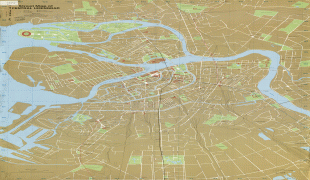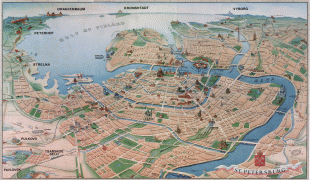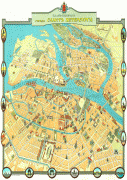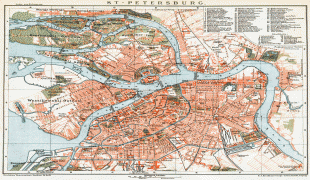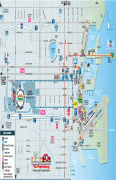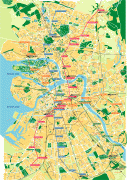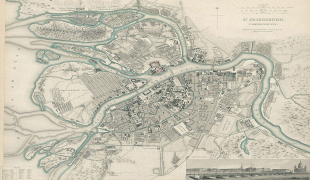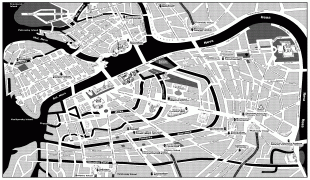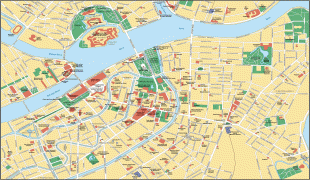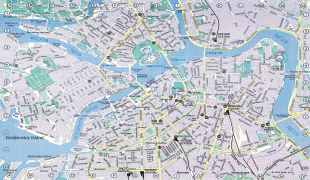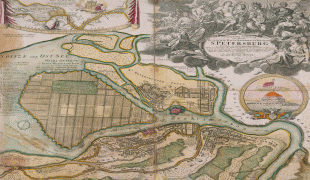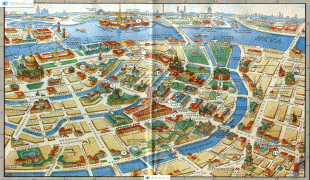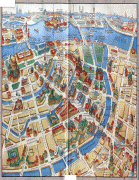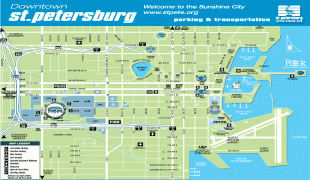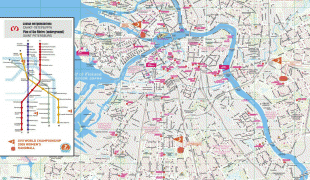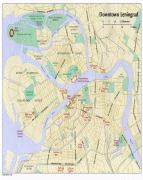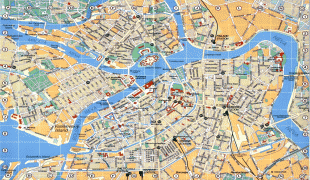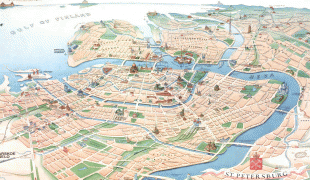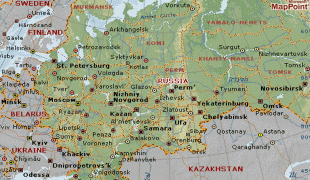Saint Petersburg (Sankt-Peterburg)
 |
 |
As Russia's cultural center, Saint Petersburg received over 15 million tourists in 2018. It is considered an important economic, scientific, and tourism centre of Russia and Europe. In modern times, the city has the nickname of being "the Northern Capital of Russia" and is home to notable federal government bodies such as the Constitutional Court of Russia and the Heraldic Council of the President of the Russian Federation. It is also a seat for the National Library of Russia and a planned location for the Supreme Court of Russia, as well as the home to the headquarters of the Russian Navy, and the Western Military District of the Russian Armed Forces. The Historic Centre of Saint Petersburg and Related Groups of Monuments constitute a UNESCO World Heritage Site. Saint Petersburg is home to the Hermitage, one of the largest art museums in the world, the Lakhta Center, the tallest skyscraper in Europe, and was one of the host cities of the 2018 FIFA World Cup and the UEFA Euro 2020.
The name day of Peter I falls on 29 June, when the Russian Orthodox Church observes the memory of apostles Peter and Paul. The consecration of the small wooden church in their names (its construction began at the same time as the citadel) made them the heavenly patrons of the Peter and Paul Fortress, while Saint Peter at the same time became the eponym of the whole city. When in June 1703 Peter the Great gave the site a new name after Saint Peter, he did not issue a naming act that established an official spelling; even in his own letters he used diverse spellings, such as Санктьпетерсьбурк (Sanktpetersburk), emulating German Sankt Petersburg, and Сантпитербурх (Santpiterburkh), emulating Dutch Sint-Pietersburgh, as Peter was multilingual and a Neerlandophile. The name was later normalized and russified to Санкт-Петербург.
A proponent of westernising Russia, Peter the Great, the then Tsar, who established the city, originally named it Sankt-Pieter-Burch (Сан(к)т-Питер-Бурхъ) in Dutch manner and later its spelling was standardised as Sankt-Peterburg (Санкт-Петербургъ) under German influence.
A former spelling of the city's name in English was Saint Petersburgh, under the influence of burgh. This spelling survives in the name of a street in the Bayswater district of London, near St Sophia's Cathedral, named after a visit by the Tsar to London in 1814.
A 14- to 15-letter-long name, composed of the three roots proved too cumbersome, and many shortened versions were used. The first General Governor of the city Menshikov is maybe also the author of the first nickname of Petersburg which he called Петри (Petri). It took some years until the known Russian spelling of this name finally settled. In 1740s Mikhail Lomonosov uses a derivative of Πετρόπολις (Петрополис, Petropolis) in a Russified form Petropol' (Петрополь). A combo Piterpol (Питерпол) also appears at this time. In any case, eventually the usage of prefix "Sankt-" ceased except for the formal official documents, where a three-letter abbreviation "СПб" (SPB) was very widely used as well.
In the 1830s Alexander Pushkin translated the "foreign" city name of "Saint Petersburg" to the more Russian Petrograd (Петроград) in one of his poems. However, it was only on 31 August 1914, after the war with Germany had begun, that Tsar Nicholas II renamed the city Petrograd in order to expunge the German words and. Since the prefix "Saint" was omitted, this act also changed the eponym and the "patron" of the city from Saint Peter to Peter the Great, its founder. On 26 January 1924, shortly after the death of Vladimir Lenin, it was renamed to Leningrad (Ленинград), meaning 'Lenin's City'. On 6 September 1991, the original name, Sankt-Peterburg, was returned by citywide referendum. Today, in English the city is known as Saint Petersburg. Local residents often refer to the city by its shortened nickname, Piter (Питер).
After the October Revolution the name Red Petrograd (Красный Петроград, Krasny Petrograd) was often used in newspapers and other prints until the city was renamed Leningrad in January 1924.
A referendum on reversing the renaming of Leningrad was held on 12 June 1991, with 54.86% of voters (with a turnout of 65%) supporting "Saint Petersburg". Renaming the city Petrograd was not an option. This change officially took effect on 6 September 1991. Meanwhile, the oblast whose administrative center is also in Saint Petersburg is still named Leningrad.
Having passed the role of capital to Petersburg, Moscow never relinquished the title of "capital", being called pervoprestolnaya ('first-throned') for 200 years. An equivalent name for Petersburg, the "Northern Capital", has re-entered usage today since several federal institutions were recently moved from Moscow to Saint Petersburg. Solemn descriptive names like "the city of three revolutions" and "the cradle of the October revolution" used in the Soviet era are reminders of the pivotal events in national history that occurred here. Petropolis is a translation of a city name to Greek, and is also a kind of descriptive name: Πέτρ- is a Greek root for 'stone', so the "city from stone" emphasizes the material that had been forcibly made obligatory for construction from the first years of the city. (The proper Greek translation is Αγία Πετρούπολη, Agia Petroupoli.)
Map - Saint Petersburg (Sankt-Peterburg)
Map
Country - Russia
 |
 |
| Flag of Russia | |
The East Slavs emerged as a recognisable group in Europe between the 3rd and 8th centuries CE. The first East Slavic state, Kievan Rus', arose in the 9th century, and in 988, it adopted Orthodox Christianity from the Byzantine Empire. Rus' ultimately disintegrated, with the Grand Duchy of Moscow growing to become the Tsardom of Russia. By the early 18th century, Russia had vastly expanded through conquest, annexation, and the efforts of Russian explorers, developing into the Russian Empire, which remains the third-largest empire in history. However, with the Russian Revolution in 1917, Russia's monarchic rule was abolished and replaced by the Russian SFSR—the world's first constitutionally socialist state. Following the Russian Civil War, the Russian SFSR established the Soviet Union (with three other Soviet republics), within which it was the largest and principal constituent. At the expense of millions of lives, the Soviet Union underwent rapid industrialization in the 1930s, and later played a decisive role for the Allies of World War II by leading large-scale efforts on the Eastern Front. With the onset of the Cold War, it competed with the United States for global ideological influence; the Soviet era of the 20th century saw some of the most significant Russian technological achievements, including the first human-made satellite and the first human expedition into outer space.
Currency / Language
| ISO | Currency | Symbol | Significant figures |
|---|---|---|---|
| RUB | Russian ruble | ₽ | 2 |
| ISO | Language |
|---|---|
| CE | Chechen language |
| CV | Chuvash language |
| KV | Komi language |
| RU | Russian language |
| TT | Tatar language |






